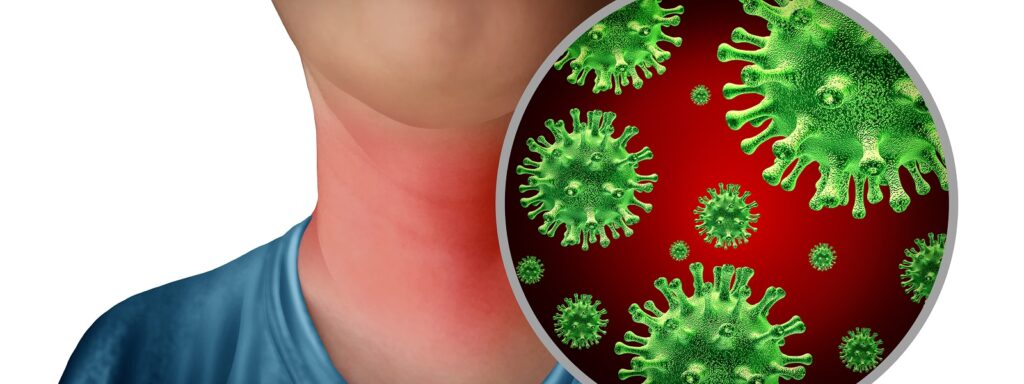
Para leer en Español, por favor haga clic aquí
Tonsillitis is common, especially in children. Thankfully, most cases of tonsillitis don’t cause long-term complications. Symptoms of tonsillitis, however, can mimic the symptoms of COVID-19, which can be alarming. Cooper’s infectious diseases expert can help you differentiate the two.
“Tonsils are glands at the back of the throat that make antibodies that help fight infection. Tonsillitis occurs when the tonsils become inflamed and infected – usually from bacteria or viruses,” says Raquel Nahra, MD, Infectious Diseases Specialist at Cooper University Health Care. “While seen most often in children, adults can develop tonsillitis as well at any age. Tonsillitis is usually accompanied by fever and sore throat.”
Other signs and symptoms of tonsillitis include swollen tonsils, sore throat, difficulty swallowing and tender lymph nodes on the sides of the neck. Tonsillitis caused by a virus will usually go away on its own, but if it is caused by a bacteria, you may need medication such as antibiotics.
COVID-19 is an infectious disease caused by the coronavirus. Symptoms of COVID-19 include dry cough, fever, and in more severe cases, difficulty breathing.
“You can protect yourself from COVID-19 by washing your hands frequently, avoiding touching your face, wearing a face mask, and practicing physical distancing,” says Dr. Nahra. “If you are experiencing any symptoms of tonsillitis, or COVID-19, contact your primary health care provider for an evaluation.”
Coronavirus vs. Tonsillitis
| SYMPTOMS | COVID-19 | TONSILLITIS |
| Fever | X | X |
| Sore throat | X | X |
| Digestive discomfort | X | X |
| Headache | X | X |
| Cough | Dry (no mucus) | |
| Chest pain | X | |
| Nasal congestion | X | |
| Shortness of breath | X | |
| Bluish lips or face | X | |
| Chills and aches | X | |
| Loss of smell and taste | X | |
| Conjunctivitis (pink eye) | X | |
| Tiredness | X | |
| Red, swollen tonsils | X | |
| White or yellow coating/patches on tonsils | X | |
| Difficulty swallowing | X | |
| Enlarged, tender lymph nodes in the neck | X | |
| Scratchy voice | X | |
| Bad breath | X | |
| Stiff neck | X |
If you have flu-like symptoms and think you may have been exposed to COVID-19, review our instructions and information on our testing sites. If you believe you have an ear infection, call 800.826.6737 to make an appointment with an expert from the Division of Otolaryngology to discuss your options.
¿Es COVID-19 o amigdalitis?
La amigdalitis es común, especialmente en niños. Afortunadamente, la mayoría de los casos de amigdalitis no causan complicaciones a largo plazo. Sin embargo, los síntomas de la amigdalitis pueden imitar los síntomas del COVID-19, que pueden ser alarmantes. El experto en enfermedades infecciosas de Cooper puede ayudarlo a diferenciar los dos.
“Las amígdalas son glándulas ubicadas en la parte posterior de la garganta que producen anticuerpos que ayudan a combatir las infecciones. La amigdalitis ocurre cuando las amígdalas se inflaman e infectan, generalmente por bacterias o virus ”, dice Raquel Nahra, MD, Especialista en Enfermedades Infecciosas de Cooper University Health Care. “Aunque se observa con mayor frecuencia en niños, los adultos también pueden desarrollar amigdalitis a cualquier edad. La amigdalitis suele ir acompañada de fiebre y dolor de garganta “.
Otros signos y síntomas de amigdalitis incluyen amígdalas inflamadas, dolor de garganta, dificultad para tragar y ganglios linfáticos sensibles a los lados del cuello. La amigdalitis causada por un virus generalmente desaparece por sí sola, pero si es causada por una bacteria, es posible que necesite medicamentos como antibióticos.
COVID-19 es una enfermedad infecciosa causada por el coronavirus. Los síntomas de COVID-19 incluyen tos seca, fiebre y, en casos más graves, dificultad para respirar.
“Puede protegerse del COVID-19 lavándose las manos con frecuencia, evitando tocarse la cara, usando una mascarilla y practicando el distanciamiento físico”, dice el Dr. Nahra. “Si tiene algún síntoma de amigdalitis o COVID-19, comuníquese con su proveedor de atención médica primaria para una evaluación”.
Coronavirus versus Amigdalitis
| SINTOMAS | COVID-19 | AMIGDALITIS |
| Fiebre | X | X |
| Dolor de garganta | X | X |
| Malestar digestivo | X | X |
| Dolor de cabeza | X | X |
| Tos | Seca (no mucus) | |
| Dolor de pecho | X | |
| Congestión nasal | X | |
| Dificultad para respirar | X | |
| Labios o cara azulados | X | |
| Escalofríos y dolores | X | |
| Perdida del olfato y el gusto | X | |
| Conjuntivitis | X | |
| Cansancio | X | |
| Amígdalas rojas o hinchadas | X | |
| Capa / manchas blancas o amarillas en las amígdalas | X | |
| Dificultad tragando | X | |
| Ganglios linfáticos agrandados y sensibles en el cuello | X | |
| Voz rasposa | X | |
| Mal aliento | X | |
| Rigidez de nuca | X |
Si tiene síntomas similares a los de la gripe y cree que pudo haber estado expuesto al COVID-19, revise nuestras instrucciones e información en nuestros sitios de prueba. Si cree que tiene una infección de oído, llame al 800.826.6737 para programar una cita con un experto de la División de Otorrinolaringología para analizar sus opciones.

Very helpful, thank you